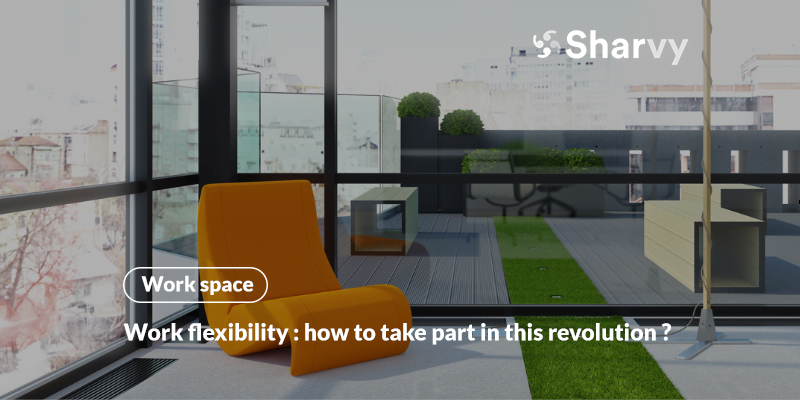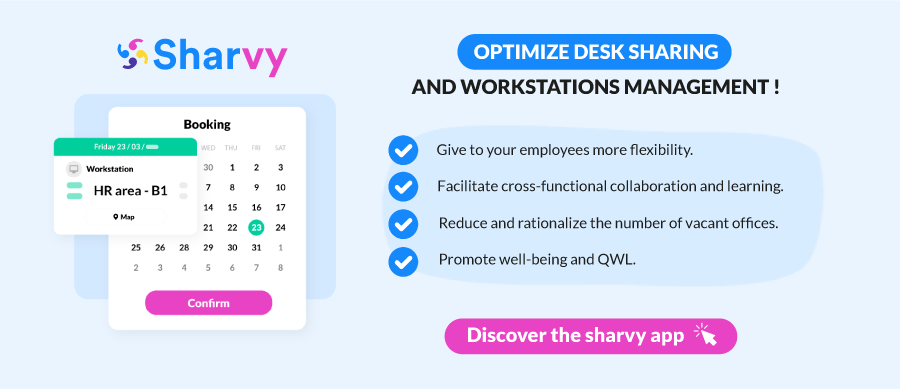Barely out of a global health crisis, and when the idea of a “world after” is taking hold in our minds, we are already witnessing profound changes in the world of work.
At a time when a way out of the health crisis is taking shape, and the idea of a “post-war world” is taking hold in our minds, we are already witnessing profound changes in the world of work.
Employees now want to combine work and flexibility harmoniously. This trend was already noticeable before the health crisis began. However, it has been amplified during the pandemic and the telecommuting experience. Now, according to a recent study by LinkedIn, more than 87% of employees aspire to telecommute at least once or twice a week. At the same time, it highlights that employees who benefit from this organizational flexibility are twice as happy to work for their company.
Therefore, it is clear that this notion of work flexibility is nowadays particularly appreciated by employees. That’s why companies must participate in this revolution if they want to operate more agilely and attract the best talents.
In this article, find out how you can do this as a company and the best practices to implement!
A reminder of what is meant by the notion of “work flexibility” !
Progressively introduced in companies, the notion of work flexibility directly implies questioning the organization of work on the company’s part.
In other words, it implies that the needs of each employee are unique. Therefore, each employee should be able to organize their work personalized. In particular, they should be able to telework, to arrange their working hours according to their personal and family needs, and thus, not be constrained by the famous 9 to 6 working hours. Therefore, by enjoying greater flexibility in the organization of their work week, employees can more easily find a better balance between their professional life and their personal needs.
These flexible working methods have been made possible by the countless technological advances of recent years. But also by the ability of employees to master various tools (e.g., video conferencing, project management, and task management tools) that allow everyone to discuss and work efficiently, remotely, and from any geographical location.
Thus, despite the persistent culture of presenteeism in France, companies introducing more flexibility in the workplace are aware of the opportunities that this notion holds for their competitiveness and the well-being of their employees. Consequently, for these companies, the idea of flexibility at work rhymes with respect for the needs of each individual. Thus, everything is possible and discussable, and everyone wins!
Why has work flexibility become more prevalent in recent years?
If work flexibility tends to develop (with flex desk, hot desking…) it is because both employees and companies benefit from it. So let’s see what these benefits are on both sides!
1. Work flexibility in the eyes of companies
In a context of uncertainty and permanent changes, companies have no other solution than to be agile and adapt to their environment. However, as we observed during the Covid-19 crisis, it can be challenging to get through such a crisis and minimize the disruption caused.
In situations like this, the notion of work flexibility takes on its whole meaning. In a crisis situation, it allows companies to stop worrying about their activities’ operational continuity and focus on maintaining their efficiency. Finally, it acts as a safety net!
As a result, flexibility is gradually gaining ground in companies from a situation that initially suffered. It creates a virtuous circle that promotes employee commitment and productivity. The latter finds the desire to work again, and relationships of trust are established in the long term, provided that this flexibility is chosen and not imposed.
Therefore, if it is well managed, this shift can be revolutionary for companies in terms of competitiveness, innovation, and agility!
2. Work flexibility in the eyes of employees
Increasingly popular with employees, work flexibility is now a requirement for a large part of the working population. According to a recent study conducted by IFOP for BNP Paribas Real Estate, one employee out of two wants more flexibility in the organization of his working time, and more than 53% want to telework a few days a week.
However, these results are not surprising, given the benefits of flexibility and adaptability at work.
On the one hand, by offering more freedom in managing their working time, the company maintains a relationship of trust with its employees. In this sense, it boosts the notions of responsibility and autonomy that each employee must demonstrate, stimulating commitment and motivation. Ultimately, this flexibility allows them to grow professionally and achieve a certain satisfaction. Satisfaction today is at the heart of the productivity and performance of the company. In other words: employees are happy and fulfilled, and human skills are valued thanks to the flexibility shown by the company!
On the other hand, by abandoning presenteeism in favor of telecommuting and flexible working hours, employees can better balance their time between professional missions and personal constraints. This reduces absenteeism, turnover, and sick days while reducing stress, environmental impact, and the need to travel and come to work.
Work flexibility : what are the keys to a successful transformation?
1. Define a clear framework, with clear and shared rules and practices!
One of the first things to consider for a successful transition is : defining a clear framework.
This may seem contradictory, but defining a common frame of reference is essential, with rules that everyone must respect. In this way, the company ensures that its flexibility policy runs smoothly and makes it easier to create win-win relationships.
To achieve this, some questions will help you define clear rules and practices within your company. In particular :
- What is the pace of remote work? One or two days a week, or more?
- Do you allow or prohibit telecommuting during team meetings?
- During what time frame are employees required to be available?
- Are employees allowed to work away from home?
- What equipment is available for telecommuting?
- What level of confidentiality is expected when telecommuting?
By answering these questions, you will establish standard rules for each employee. At the same time, it allows you to prevent the emergence of possible conflicts related to the implementation of hybrid work. In addition, you harmonize the practices of the whole team and put everyone on an equal footing!
2. Integrate digital tools to cultivate team spirit and foster collaborative work!
To successfully manage this transition, it is essential to implement various digital tools. On the one hand, to limit the isolation of certain employees. On the other hand, it encourages collaborative work and maintains exchanges, even at a distance.
From now on, there are many solutions! For example, we can mention :
- Collaborative project management tools, such as : Asana, Notion, Trello, Monday, etc.
- Team communication & videoconferencing tools : Teams, Google Chat, Google Meet, Slack, etc.
- Tools that offer document sharing : Google Drive, SharePoint, WeTransfer, etc.
These tools are essential to preserving the group dynamic and the motivation of everyone!
The advent of new flexible work modes within companies has drastically reduced the occupancy rate of workplaces from 80% to 60%. Therefore, companies must understand that the transition to flexible and adaptable work goes hand in hand with a new layout of spaces.
Agile and user-friendly, desk sharing is one of the most appropriate solutions for optimizing shared spaces in companies.
Conducive to a dynamic work environment, these shared offices (flex desk) offer employees the flexibility they are looking for and allow them to break the routine, stimulate creativity and encourage interaction between colleagues and collaborative projects!
At the same time, the advantages of desk sharing are just as numerous on the company side. Remember that today, offices represent a significant expense for companies. It is even the second-largest expense after payroll. This is why many companies have abandoned the traditional office in favor of shared spaces.
To facilitate this transition to desk sharing, it is wise to equip yourself with a digital solution for managing shared spaces in companies. In this way, you can help your employees adopt these new flexible working methods daily. Employees can reserve a workstation and/or a meeting room with a few clicks. At the same time, they can check availability for the next few days to organize their week and anticipate their personal constraints through an intuitive web & mobile application like Sharvy!
4. Do not fail to make decisions that represent the collective intelligence
In other words, it is about finding a good balance between consensus and individual decision-making. Each employee’s needs and personal wishes must be listened to and considered.
However, the final decision must be made by one person while representing the collective intelligence. This is one of the real benefits of a flexible organization at work.
In this way, the company moves forward according to its values while reinforcing the company culture and the involvement of its employees.
5. Don’t neglect the workspaces for a successful transition to work flexibility!
Flexibility and adaptability in the workplace do not mean desertion of the office! Therefore, it is up to the employer to make employees want to come to work to allow for a better transition.
On the one hand, finding the right balance between office and collective spaces is essential. The latter’s layout must be neat, clever, and connected to meet everyone’s needs. For example, choosing to work in an open space must be accompanied by areas for relaxation and concentration. In this way, the company manages to create a stimulating work environment that improves the well-being of its employees.
On the other hand, the employer must think of enhancing the common spaces. Even today, many companies still regard their “relaxation” areas as the last wheel of the carriage, confining them to dark and cluttered corners. And obviously, these spaces are not conducive to exchanges and conviviality. This is why, when a company undertakes the transition to more flexibility at work, it must think of taking advantage of this new office organization.
In this way,it puts its employees’ quality of life and well-being first and makes them want to come to the office a few days a week!
In conclusion
The world of work is constantly evolving, and shifting to flexibility is a way to become more forward-looking and agile. However, before taking part in this revolution and undertaking this transition, it is essential to take note of the above tips. Indeed, after the progress of digital technology and following exceptional situations (financial crisis, global pandemic) and the evolution of social norms, it is essential not to be overwhelmed by the consequences of these events, to improve the Quality of Life and Working Conditions (QLWC) over the long term. This is why this transition must be carried out step by step, and employees must be accompanied for a successful adoption!
Have a question? Check out the FAQ!
How can you monitor the development of your employees and the success of this new organization?
Transitioning to a new work organization is not always easy for all employees. That’s why it is essential to establish a follow-up to give yourself the best chance to unite your teams to this new approach. To do this, you must first collect your employees’ feelings, ensure everyone is on board, and collect any unique needs to be met. On the other hand, think about taking into account their testimonies and adapting your approach in return. The idea is to initiate a flexible work approach aligned with your corporate culture and your employees’ aspirations.
Is it mandatory to create a telework charter when you want to introduce more flexibility?
A telework policy is not mandatory, but it is recommended. When a company is moving towards flexibility, it is wise to define the rules applicable to telework, frame this new organization, and put all employees on an equal footing. In this way, employees are aware of their rights and obligations. The objective is to avoid abuse and/or possible conflicts by promoting transparency and communication.
What are the main digital tools that facilitate the transition to a flexible work organization in a modern work environment?
The transition to a new flexible workspace requires the adoption of appropriate digital tools to support new ways of working. Among the most effective are project management platforms like Asana or Trello, which foster collaboration in coworking spaces or when working remotely. Video conferencing tools such as Zoom or Microsoft Teams play a crucial role in maintaining team spirit in dispersed environments. Additionally, solutions like Google Drive or SharePoint provide easy access to documents, no matter where the nomadic employees are located. These tools not only support the flexibility of workspaces but also enhance workplace well-being by allowing employees to work remotely while staying connected to their teams.
Want to learn more? Check out our latest articles!
Flexible working : an eldorado of freedom?
Is flexible working (really) a guarantee of freedom? Definition, benefits, prerequisites, risks and best practice right here!
Future of work : what trends and technologies lie behind this notion?
Between utopia and dystopia, what can managers expect and how can they prepare for the “Future of work” ? The answers here!
Smart parking : a key link for your CSR policy!
What are the benefits of smart parking for your CSR policy? How do you set it up? What solutions can you turn to? Find the answers here!
Subscribe to our newsletter!
Resources
Contact us
+44 117 463 6990






